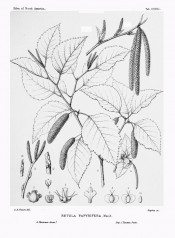Betula papyrifera Michx.
Large, hardy, graceful, deciduous tree with ovate leaves, to 10cm long, white papery bark and yellow autumn foliage. There are a number of naturally occurring forms. To 30m. [RHSD, Hortus, Hilliers’].
Horticultural & Botanical History
‘The Canoe Birch is one of the most widely distributed trees of North America. From Labrador it ranges to the southern shores of Hudson’s Bay and to those of the Great Bear Lake, and to the valley of the Yukon River and the coast of Alaska, forming with the Aspen, the Larch, the Balsam Poplar, the Banksian Pine, the Black and the White Spruces, and the Balsam Fir, the great subarctic transcontinental forest; and southward it ranges through all the forest region of the Dominion of Canada and the northern states to Long Island, New York, and northern Pennsylvania, central Michigan and Minnesota, the bluffs of the Niobrara River in northern Nebraska, the Black Hills of Dakota, northern Montana, and northwestern Washington. An inhabitant of rich woody slopes and the borders of streams, lakes, and swamps, the Canoe Birch, although it never forms a large part of the forest, is very common in the maritime provinces of Canada, in the region immediately north of the Great Lakes, and in northern New England and New York, where it ascends to higher elevations than any other deciduous-leaved tree; it is small and comparatively rare in the coast region of southern New England, in southern New York, and in central Minnesota; widely distributed at high latitudes from Labrador to the eastern base of the Rocky Mountains, it is never very abundant here or a conspicuous object in the landscape, and within the Arctic Circle becomes small and crooked; west of the RockyMountains, where it attains its largest size, the Canoe Birch usually grows singly, and is found only along the banks of streams.
The wood of Betula papyrifera is light, strong, hard, tough, and very close-grained; it is light brown tinged with red, with thick nearly white sapwood, and contains numerous obscure medullary rays. The specific gravity of the absolutely dry wood is 0.5955, a cubic foot weighing 37.11 pounds. It is largely used in the making of spools, for which purpose it is preferred to the wood of other American trees, and of shoe-lasts and pegs, in turnery, in the manufacture of wood-pulp, and for fuel. The Indians of the north employ it for their sledges and paddles, the frames of their snow-shoes, and the handles of their hatchets. The tough resinous durable bark of this tree, easily separated into thin layers, and impervious to water, is indispensable to all the northern tribes of Indians; with it they build their canoes and manufacture baskets, bags, drinking-cups, and many other articles of domestic use; and when the skins of large animals cannot be obtained, it protects their wigwams from the inclemency of the boreal winter.
The sweet sap, which flows freely in early spring from wounds made in the trunk of the Canoe Birch, furnishes the Indians with a pleasant cooling drink, or by boiling can be made into a syrup. According to Aiton, Betula papyrifera was introduced in 1750 by the Duke of Argyll into English plantations.’ [Sargent - Silva of North America vol.9, p.58, pl.CCCCLI/1896].
History at Camden Park
Betula papyracea is marked with a ‘c’ in an 1836 edition of Loddiges’ catalogue held at Camden Park [CPA]. In William Macarthur’s code, used and explained elsewhere, this means grown at Camden. It is almost certain that it was grown in the gardens around this time but may have been short lived as it did not appear in the catalogues.
Notes
Published Apr 01, 2010 - 05:24 PM | Last updated Apr 01, 2010 - 05:30 PM
| Family | Betulaceae |
|---|---|
| Category | |
| Region of origin | Northern North America |
| Synonyms |
|
| Common Name | Paper birch, Canoe birch |
| Name in the Camden Park Record |
Betula papyracea |
| Confidence level | high |


